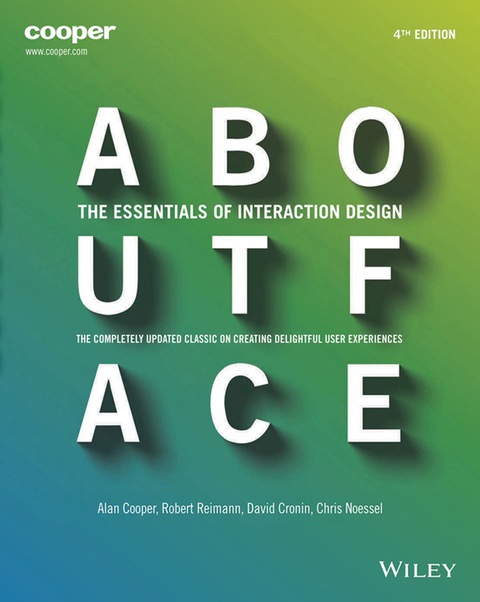Description
Efnisyfirlit
- Part I: Goal-Directed Design
- CH 1: A Design Process for Digital Products
- The Consequences of Poor Product Behavior
- Why Digital Products Fail
- Planning and Designing Product Behavior
- Recognizing User Goals
- Implementation Models and Mental Models
- An Overview of Goal-Directed Design
- CH 2: Understanding the Problem: Design Research
- Qualitative versus Quantitative Data in Design Research
- Goal-Directed Design Research
- Interviewing and Observing Users
- Other Types of Qualitative Research
- Research Is Critical to Good Design
- CH 3: Modeling Users: Personas and Goals
- Why Model?
- The Power of Personas
- Why Personas Are Effective
- Understanding Goals
- Constructing Personas
- Personas in Practice
- Other Design Models
- CH 4: Setting the Vision: Scenarios and Design Requirements
- Bridging the Research-Design Gap
- Scenarios: Narrative as a Design Tool
- Design Requirements: The “What” of Interaction
- The Requirements Definition Process
- CH 5: Designing the Product: Framework and Refinement
- Creating the Design Framework
- Refining the Form and Behavior
- Validating and Testing the Design
- CH 6: Creative Teamwork
- Small, Focused Teams
- Thinking Better, Together
- Working Across Design Disciplines
- The Extended Team
- Establishing a Creative Culture
- Identifying Skill Levels in Designers
- Collaboration Is the Key
- Part II: Designing Behavior and Form
- CH 7: A Basis for Good Product Behavior
- Design Values
- Interaction Design Principles
- Interaction Design Patterns
- CH 8: Digital Etiquette
- Designing Considerate Products
- Designing Smart Products
- Designing Social Products
- CH 9: Platform and Posture
- Product Platforms
- Product Postures
- Postures for the Desktop
- Postures for the Web
- Postures for Mobile Devices
- Postures for Other Platforms
- Give Your Apps Good Posture
- CH 10: Optimizing for Intermediates
- Perpetual Intermediates
- Inflecting the Interface
- Designing for Three Levels of Experience
- CH 11: Orchestration and Flow
- Flow and Transparency
- Orchestration
- Harmonious Interactions
- Motion, Timing, and Transitions
- The Ideal of Effortlessness
- CH 12: Reducing Work and Eliminating Excise
- Goal-Directed Tasks versus Excise Tasks
- Types of Excise
- Excise Is Contextual
- Eliminating Excise
- Other Common Excise Traps
- CH 13: Metaphors, Idioms, and Affordances
- Interface Paradigms
- Building Idioms
- Manual Affordances
- Direct Manipulation and Pliancy
- Escape the Grip of Metaphor
- CH 14: Rethinking Data Entry, Storage, and Retrieval
- Rethinking Data Entry
- Rethinking Data Storage
- Rethinking Data Retrieval
- CH 15: Preventing Errors and Informing Decisions
- Using Rich Modeless Feedback
- Undo, Redo, and Reversible Histories
- What If: Compare and Preview
- CH 16: Designing for Different Needs
- Learnability and Help
- Customizability
- Localization and Globalization
- Accessibility
- CH 17: Integrating Visual Design
- Visual Art and Visual Design
- The Elements of Visual Interface Design
- Visual Interface Design Principles
- Visual Information Design Principles
- Consistency and Standards
- Part III: Interaction Details
- CH 18: Designing for the Desktop
- Anatomy of a Desktop App
- Windows on the Desktop
- Menus
- Toolbars, Palettes, and Sidebars
- Pointing, Selection, and Direct Manipulation
- CH 19: Designing for Mobile and Other Devices
- Anatomy of a Mobile App
- Mobile Navigation, Content, and Control Idioms
- Multi-Touch Gestures
- Inter-App Integration
- Other Devices
- CH 20: Designing for the Web
- Page-Based Interactions
- The Mobile Web
- The Future
- CH 21: Design Details: Controls and Dialogs
- Controls
- Dialogs
- Eliminating Errors, Alerts, and Confirmations
- The Devil Is in the Details
- Appendix A: Design Principles
- Chapter 1
- Chapter 3
- Chapter 4
- Chapter 5
- Chapter 8
- Chapter 9
- Chapter 10
- Chapter 11
- Chapter 12
- Chapter 13
- Chapter 14
- Chapter 17
- Chapter 18
- Chapter 19
- Chapter 20
- Chapter 21
- Appendix B: Bibliography
- Titlepage
- Copyright
- Credits
- Dedication
- About the Authors
- Acknowledgments
- Foreword
- Introduction to the Fourth Edition
- A Brief History of Interaction Design
- IxD and User Experience
- What This Book Is and What It Is Not
- How This Book Is Structured
- Changes Since the Third Edition
- Examples Used in This Book
- Who Should Read This Book
- Advertisement
- End-User License Agreement






Reviews
There are no reviews yet.